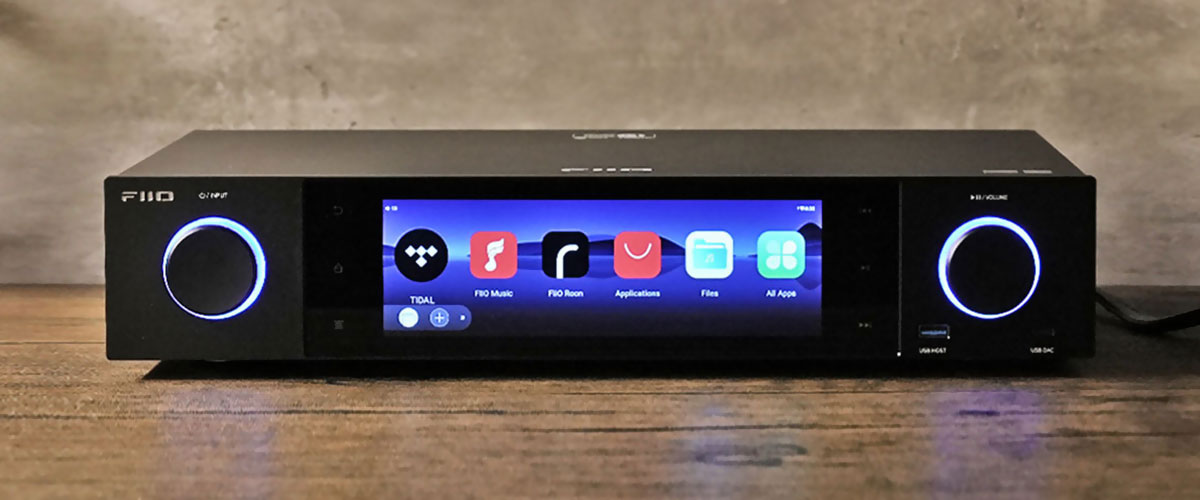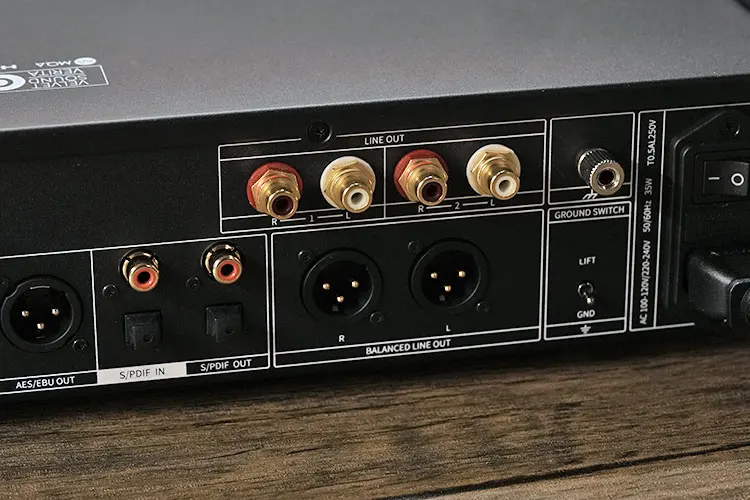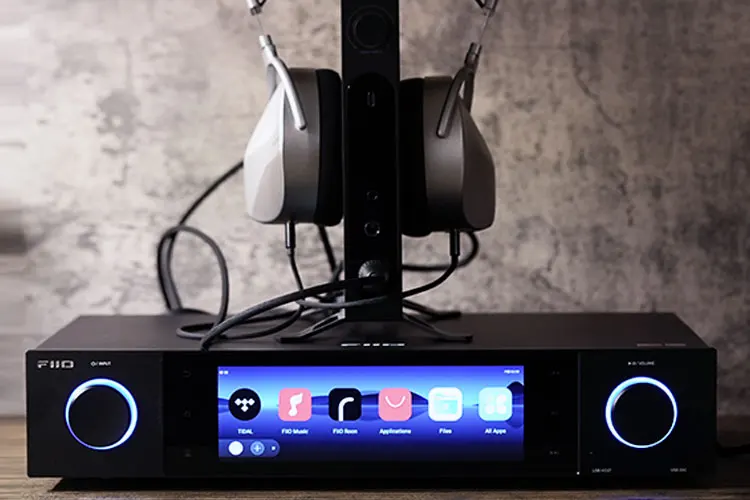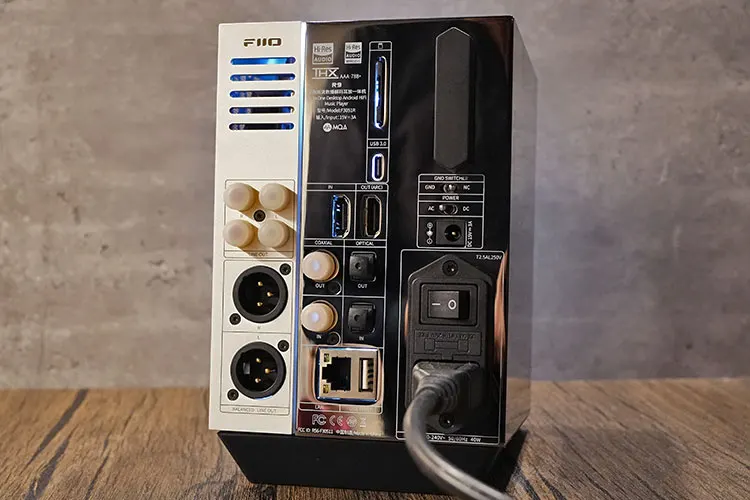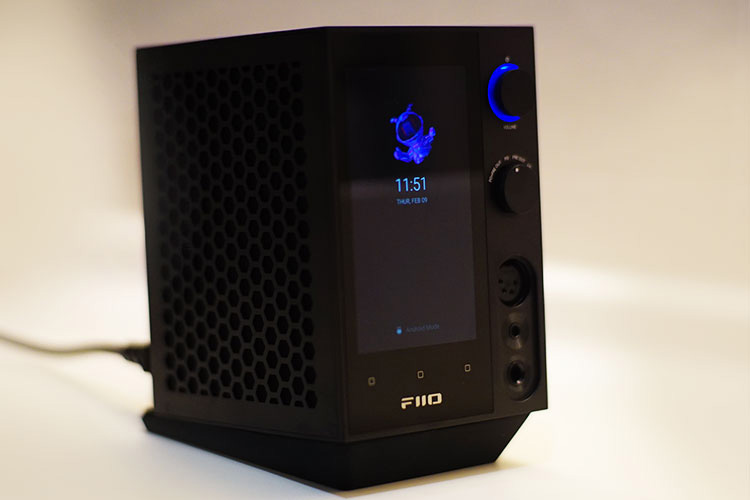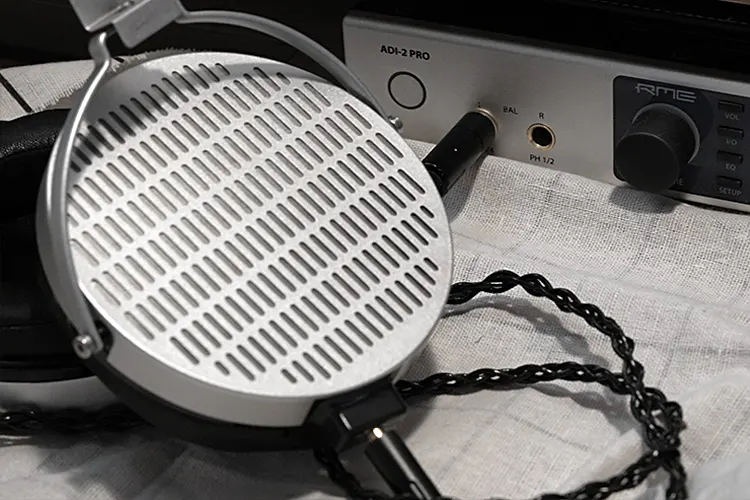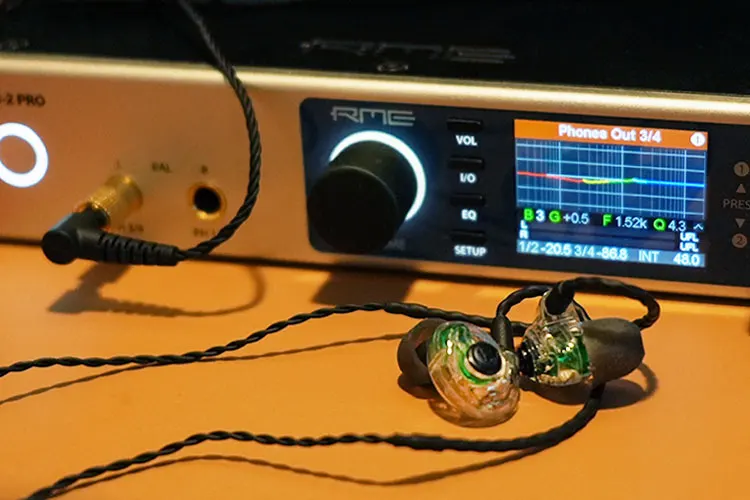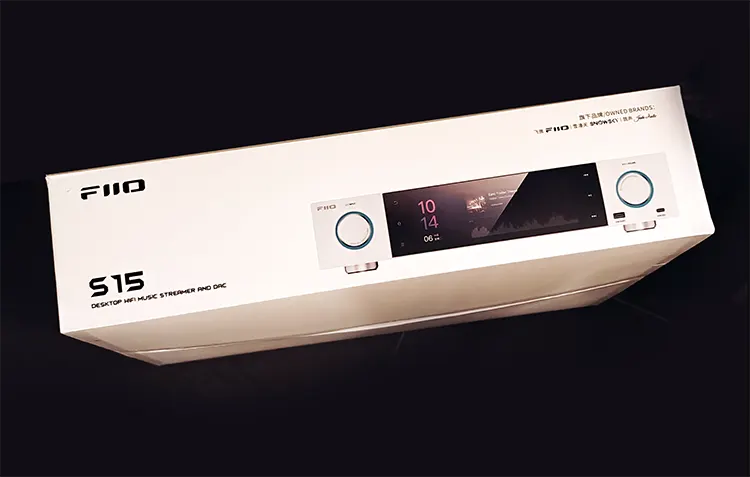Sound Impressions
For the following sound impressions, the S15 was run for about 100 hours. Testing was completed using the FiiO K19, K9 Pro ESS, and the RME ADI-2 Pro as a source or connected over coaxial to another decoder.
For headgear, I used the Sennheiser HD 800s, HIFIMAN’s ISVARNA, and the Meze Audio 105 AER to examine the output.
Summary
Equipped with a linear power supply, less packed components, and thicker shielding from the enclosure, the S15 delivers satisfactory technical performance, dynamic range, and power.
With powerful amplification and high detail retrieval power from the DAC, the S15 could easily outperform older entry to mid-end CD players and Bluetooth receivers, particularly in terms of bass power, depth, and vocal separation.
Timbre
Testing the balanced output on the S15 connected to the K19 while streaming Tidal maintains a good balance and offers a respectable level of resolution.
The bass is energetic, kicking deep and fast with a powerful attack and clean decay. Cymbals are crisply presented without sharpness, featuring detectable rumbles and satisfactory separation power, especially suitable for Classical music without inducing congestion.
Listening on the HD 800s feels natural and dynamic; a slight adjustment in the midrange using the built-in equalizer can enhance vocal harmonies and nuances, adding to a euphonic experience.
Switching to the K9 Pro ESS using the RCA connection sees a slight drop in resolution, but dynamics remain strong, with added warmth in the midrange.
The RCA output, while generally neutral and enjoyable, falls slightly behind the XLR connection in staging separation and texture, which remains audibly superior.
When using the coaxial output from the S15 with the K9 Pro ESS decoder, the mid-bass gains prominence, with vocals sounding richer and more naturally rounded.
Although Bluetooth decoding exhibits decent dynamics, it falls short of the quality provided by local playback or USB decoding. Notably so in its treble extension which lacks a sense of effortlessness and displays a more noticeable roll-off.
Staging & Dynamics
A dark background on the S15 enhances its dynamics and perceived separation, allowing instruments to be easily distinguished and transients in the bass to be captured with precision, defining the soundscapes and adding depth to the listening experience.
The controlled tuning of the bass, with a relatively concise decay, contributes to an expansive yet balanced staging that avoids exaggeration. Layering could benefit from a bassier, more textured pairing to further enhance the overall depth and richness of the sound.
Vocals separation is satisfactory with good resolution, although the tuning prioritizes smoothness over vocal body emphasis, resulting in a more laid-back presentation, particularly with darker voices.
The treble is well-controlled, maintaining composure even with intense soprano performances, ensuring that dynamics are preserved without any harshness or distortion.
Synergy
With a 35W power supply unit inside the S15, it feels fairly powerful. The lineout can reach 8.9Vrms which is quite decent for an integrated player.
All outputs sound well-defined and controlled, with the stronger output swing also helping with noise control when you are connecting it to another amplifier.
The S15 offers great versatility in pairing options, particularly with amplifiers, where it excels in dynamics and bass textures, presenting a natural and neutral sound profile without harshness or excessive bass emphasis.
Paired with the K9 Pro ESS and K19, it delivers resolving and euphonic sound even without the help of EQ adjustments.
The rather neutral tuning also reserves sufficient room for EQ adjustment and pairing with more colored amplifiers or tube amps that can help thicken the vocal texture by enriching the vocal harmonics.
For optimal performance, I would advise using the XLR output whenever feasible, as it provides superior dynamics and contrast compared to the RCA output.
Select Comparisons
FiiO R9
Technical
The FiiO R9 is an integrated desktop streamer and player that operates on the Android platform, featuring dual 8-channel ES9038PRO decoding chipsets connected in parallel for a fully differential output.
It incorporates THX AAA 788+ amplifying modules and is equipped with a 40W low-noise power supply unit, slightly more potent than the S15.
In contrast to the S15, the R9 is tailored more towards portable users, sporting a portrait orientation and offering various connections tailored for headphones and earphones.
One notable distinction is the signal-to-noise ratio (SNR), which is over 5dB higher on the S15 (>131dB) compared to the R9 (>126dB). This discrepancy could be attributed to the layout design, facilitating better shielding between components.
The larger form factor of the S15 accommodates a bigger screen and allows for dedicated features like the built-in ejectable M.2 hard disk case. Additionally, the S15 provides a broader range of I/O options, including separated Coaxial/Optical inputs and output jacks.
Design
The FiiO R9 and the S15 exhibit notable differences in form factor and functionality. The R9 is approximately 1/5th the size of the S15, yet manages to incorporate a nearly comparable array of features, given its additional headphone amplifier capabilities.
The R9’s polished stainless housing reflects its higher price point, while the S15 maintains a professional and sleek appearance with its large premium-looking screen.
In terms of usability, the S15’s customized firmware and user-friendly orientation make it well-suited for home systems. Its simplified UI with intuitive shortcuts offers a clean and efficient design.
While both devices share similar features, the S15 may be a more budget-friendly option for users who do not require the headphone amplifier functionalities provided by the R9.
Performance
When comparing the XLR lineout performance of both devices, the S15 and R9 exhibit similarities in detail retrieval but differ slightly in character. The R9 offers a slightly more layered and elaborate bass response, with a natural roundness in the treble.
In contrast, the S15 delivers cleaner and faster bass transients, providing a more agile impression but with less elaborate decay. The S15 also articulates the mids more smoothly, resulting in a slightly softer yet more neutral presentation in this frequency range.
Despite these differences, the perceived level of detail and texture from the lineout outputs of both devices is quite similar. The tonal qualities of the decoding chipsets may play a significant role in shaping the sound output.
While the tuning of the R9 may be more enjoyable for some listeners, the S15 offers a close performance and can be further tweaked using PMEQ or paired with amplifiers that emphasize relaxing, deep bass and elaborated mids.
Considering the above, if you do not require the headphone amplification function and have sufficient space available, or if you are simply looking for a source for your headphone amplifier, the S15 is a more competitive choice.
FiiO R7
Technical
The FiiO R7 is a simplified version of the R9 with an ESS ES9068AS DAC combined with dual THX AAA 788+ amplification modules for its headphone amping circuitry.
The R7 outputs 3650mW max per channel @32Ω load, and the SNR reaches >122dB (A-weighted), with an output impedance of < 0.5ohm and <0.0005% THD+N which is decent.
Design
The R7 has a much smaller, 4.97 inches 720 * 1280 screen and a similar form factor and connectivity to the R9. At a fraction of the R9’s price, it still features a full metallic housing, but of course, it is not as fancy as the artistic, stainless housing on the R9.
The experience with the R7 is quite similar to the R9 mentioned above. Both of them are more optimized for desktop headphone owners who want an all-in-one experience.
Performance
Listening to the S15’s and R7’s output on the K19, it is obvious that the S15 is way more capable than the R7.
At the same listening volume, the S15 offers bass with a fuller punch and texture, shaping the image of bass instruments and darker voices and maintaining adequate control and a distortion-free output over higher volume levels.
The R7 has a cleaner, more controlled output that feels smoothened and not as dense and airy in the lower end. It does not punch as deep and powerful, but I would say it is more naturally extended in the treble.
The mids are also less distinctly separated compared to the S15 and the treble feels slightly more revealing on the R7.
The stronger power of the S15 gives it a competitive edge over the R7. It feels more engaging with punchier bass, though if you want a more balanced and revealing signature and listen mainly to instrumentals, the R7 may as well do a nice job.
RME ADI-2 Pro
I used the AK4490 version of the ADI-2 Pro for this comparison, listening exclusively through its XLR output, connected to devices such as the K19 and K9 Pro ESS.
I also connected Bluetooth receivers such as the FiiO BTA30 Pro to the ADI-2 Pro and connected my PC to it as a USB decoder to listen to Tidal and local files on my speaker setup.
Technical
The RME ADI-2 Pro stands out as a reputable high-end audio interface commonly employed as a source for amplifiers or directly linked to active speakers for monitoring purposes.
Similar to the S15, it features balanced XLR/RCA inputs and outputs, along with AES/EBU digital connectivity. Additionally, the ADI-2 Pro incorporates PMEQ features with multiple profiles, catering to both professional users and prosumers.
The ADI-2 Pro is designed for professionals and has a much smaller screen, unlike the huge S15, despite this I am only comparing the XLR LO I am not going to drill too deep into its design.
Performance
The ADI-2 Pro performs exceptionally well, delivering highly resolving bass and well-separated, detailed vocals without harshness while capturing great brilliance and air. The positioning of both the virtuoso and accompanying instruments is exceptionally distinct too.
In comparison, and under the same configuration, the S15 delivers firm and textured bass. Compared to the ADI-2 Pro setup, the bass feels more weighted providing the vocals with slightly more fullness and presence.
The ADI-2 Pro retains more details and nuances, especially with vocals, with voices accurately positioned, radiating from a sharper origin, defining the soundscape with more micro-details and control.
The S15 comes close in power and firmness in the lower end, sounding smoother in the upper range which may sound more forgiving at the same time, but it doesn’t give as much penetration power and definition to voices.
When listening to orchestral works, the S15 can impact firmly in the bass and recover nearly as quickly. While it may sound less clean and defined, it adds a touch of warmth and elaboration to the output with more air.
The ADI-2 Pro sounds more transparent, but the bass lacks the fullness to sound as expansive and punchy.
My Verdict
The FiiO S15’s sound performance, versatility in connectivity, and rich OS features, not to mention the large screen, combine to deliver a truly delightful streaming experience.
The FiiO S15 all-in-one player is more than just a streamer, featuring strong USB decoding, Bluetooth receiver functions, and a host of value-adding software features.
Additionally, the S15 offers practical DSP features such as PMEQ and All-to-DSD upsampling. With simple tweaks, you can further refine the soundscape, revive vintage gear, or address minor room acoustic issues.
If you are still stuck with an old CD player that limits the music you can explore with your home setup or headphones, then it is a good time to consider giving it an upgrade.
The power and decoding capability of the S15 can easily outclass mid-level CD players, especially when playing 24-bit tracks or higher resolutions.
FiiO S15 Technical Specifications
- DAC: AK4191+AK4499EX
- USB Decoding: XU316
- Bluetooth: QCC5125 (receiver)
- Color: Black/Silver
- Weight: About 5647g
- Dimensions: About 430×274.5×89.5mm
- Volume Control: Volume Knob
- Display: 7.84-inch (400*1280) Bezel-less Display
- ROM: 64GB (About 46GB available)
- RAM: 4GB
- 2 Portable Hard Disk Support: Up to 2TB
- WiFi: 2.4GHz/5GHz
- Bluetooth Transmission: 5.0
- Bluetooth Reception: 5.1
- Supported Sampling Rate:
- USB DAC: Up to 768kHz/32bit; DSD512 (Native)
- Native Decoding: Up to 384kHz/32bit; DSD256 (Native)
- USB Audio: Up to 768kHz/32bit; DSD512
- Coaxial In Decoding: Up to 192kHz/24bit
- AES In Decoding: Up to 192kHz/24bit
- Optical In Decoding: Up to 96kHz/24bit

